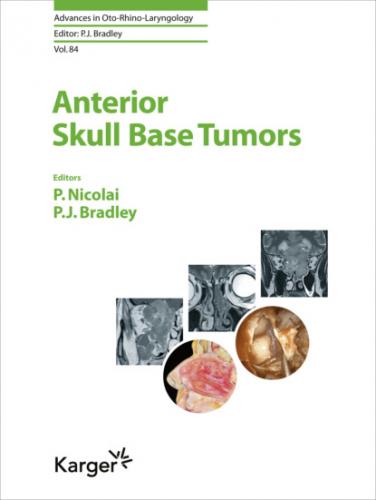Vander Poorten V.; Jorissen M. (Leuven)
Veyrat M.; Vérillaud B.; Fiaux-Camous D.; Froelich S.; Bresson D. (Paris); Nicolai P. (Brescia); Herman P. (Paris)
Neuroendocrine Carcinoma and Sinonasal Undifferentiated Carcinoma
Abdelmeguid A.S. (Houston, TX/Mansoura); Bell D.; Hanna E.Y. (Houston, TX)
Lund V.J. (London)
Castelnuovo P.; Turri-Zanoni M. (Varese)
Other Rare Sinonasal Malignant Tumours Involving the Anterior Skull Base
Naga R.; Pai P.S. (Mumbai)
Posttreatment Imaging Surveillance
Farina D.; Zorza I.; Golemi S.; Lombardi D.; Borghesi A.; Maroldi R.; Ravanelli M. (Brescia)
Treatment Options for Recurrent Anterior Skull Base Tumors
Orlandi E.; Iacovelli N.A.; Ingargiola R.; Resteghini C. (Milan); Bossi P. (Brescia); Licitra L. (Milan); Ferrari M. (Brescia/Padua); Nicolai P. (Padua)
Future Perspectives in the Management of Tumors of the Anterior Skull Base
Nicolai P. (Brescia); Bradley P.J. (Nottingham); Bossi P.; Ferrari M. (Brescia)
Nicolai P, Bradley PJ (eds): Anterior Skull Base Tumors. Adv Otorhinolaryngol. Basel, Karger, 2020, vol 84, pp VII–VII (DOI: 10.1159/000505104)
The anterior skull base can be involved in a large variety of tumors of a varying nature and histology, which in the majority of cases originate from adjacent anatomic sites. In fact, primary lesions of the anterior skull base mainly include osteoma and other tumors originating from bone and cartilage. Tumors involving the anterior skull base prevalently have their origin in the sinonasal tract, but also lesions developing on the intracranial site, such as meningiomas, may extend caudally to encroach upon this area. All these lesions are rare, meaning the pertinent literature cannot include prospective studies or treatment guidelines based on a high level of evidence.
In recent years, interest in the management of anterior skull base tumors has been fostered by the introduction and subsequent rapid expansion of indications of transnasal endoscopic techniques. In parallel, extraordinary progress has been made in all the other disciplines (pathology, radiology, neurosurgery, radiation oncology, medical oncology) which are involved in the complex process of managing anterior skull base tumors, leading to substantial improvements in diagnosis and treatment.
The present book includes 20 chapters written by experts of worldwide reputation in their respective fields. In view of the extreme histologic variability of lesions involving the anterior skull base, much emphasis has been placed on addressing the different nuances of treatment in relation to histology, especially for malignant tumors. The chapters focusing on surgery reflect the experience of the senior author, and consequently can provide divergent views on selection criteria for a specific surgical technique.
I dedicate this book to my mentor, Prof. Antonino Roberto Antonelli, who with his wisdom and vision was instrumental in my education and inspired my interest in skull base surgery. I also want to express my deep gratitude to Patrick Bradley, who had the idea for this book approximately 3 years ago, and has been the real engine throughout the entire process of preparation and editing. The book is published after some delay in relation to the original schedule for personal reasons, for which I take full responsibility. All the authors deserve my appreciation for agreeing to provide a last-minute update to their chapters.
I genuinely hope that readers will profit from this book!
Piero Nicolai, Padua, Italy
Patrick J. Bradley, Nottingham, UK
Nicolai P, Bradley PJ (eds): Anterior Skull Base Tumors. Adv Otorhinolaryngol. Basel, Karger, 2020, vol 84, pp 1–12 (DOI: 10.1159/000457921)
______________________
Macroscopic and Endoscopic Anatomy of the Anterior Skull Base and Adjacent Structures
Marco Ferraria, b Davide Mattavellia Alberto Schreibera Piero Nicolaib
aUnit of Otorhinolaryngology – Head and Neck Surgery, Department of Surgical Specialties, Radiological Sciences, and Public Health, University of Brescia, Brescia, Italy; bSection of Otorhinolaryngology – Head and Neck Surgery, Department of Neurosciences, University of Padua, Padua, Italy
______________________
Abstract
The anterior skull base can be divided into three segments: a midline and two symmetrically placed segments located laterally. The midline segment is the roof of the nasal cavity and serves as a watershed between the sinonasal tract and the intracranial space, whereas the lateral segments separate the intracranial compartment from the orbital content. Several peculiar anatomical areas make up the midline segment (posterior frontal plate, cribriform plate, ethmoidal roof, planum sphenoidale, and tuberculum sellae), while the lateral segments are more regular, formed by flat laminae (orbital plates of the frontal bones and lesser wings of the sphenoid). Here we detail each segment of the anterior skull base, emphasizing major landmarks, providing classifications and measurements of key areas, and cautioning the endoscopist about areas to avoid or minimize the occurrence of cerebrospinal fluid leaks, as well as providing recommendations and tips. Several endoscopic and sectional macroscopic anatomical images provide the reader with an informative, illustrative, and broad perspective of anterior skull base anatomy.
© 2020 S. Karger AG, Basel
The anatomy of the human skull has not changed in millennia, but following the introduction of lighting, optics, and endoscopes, innovative changes and approaches to the management of diseases and conditions of the nose, paranasal sinuses, and adjacent anatomical areas of the mid-face and anterior skull base (ASB) have occurred. This minimally invasive surgery approach, contrary to open approaches, requires that surgeons acquire detailed knowledge of local anatomy as viewed from in to outwards, allowing for a safe, targeted, and bloodless approach while pursuing the view seen from an endoscope. This surgical approach involves not only the nasoethmoidal box, but also the adjacent anatomic areas, which are not infrequently the target of so-called extended transnasal endoscopic approaches.
For this reason, the authors considered it important that the reader be updated with a review of the ASB together with photographic documentation that allows for detailed understanding of the anatomic structures encountered in a transnasal endoscopic journey toward the ASB
